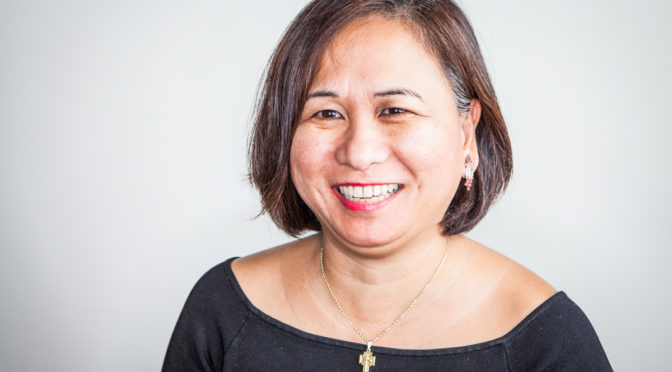In a world that has grown more and more digital, things like braille and tactile literacy may seem less and less prevalent, but for Divina Carlson, LightHouse braille Instructor, it’s just the opposite.
LightHouse has had the pleasure of calling Divina a “member of the family” for 27 years. After immigrating from The Philippines in 1989, Divina obtained her AA at the Community College of San Francisco, and a bachelor’s degree in sociology from San Francisco State University. She had her first ever formal blindness skills training from LightHouse after arriving in the United States. She became the LightHouse braille instructor in 1993.
Before LightHouse had to temporarily shut down in- person services in March, Divina was seeing about ten students regularly, working roughly 140 hours per quarter, teaching them to read and write braille and conducting student assessments. Since the COVID-19 pandemic has turned all LightHouse programs virtual, however, Divina has seen a significant influx of students and braille services. In the past six months she has taken on more than twice as many students and has nearly doubled her instruction time. While there has a been bit of adjustment in her teaching approaches, braille student participation has never looked better.
“Even before COVID, I actually started teaching braille remotely to some of my students who cannot come to LightHouse due to various reasons,” She said. “[Students] just have to have the braille materials needed and a hands-free speakerphone at home. When the quarantine happened, I already had ideas about how I would work with my students.”
Divina acknowledges there are challenges.
“Producing the assessment tools can take time, as I cannot mail the students the assessment and braille readiness materials, I normally use at the LightHouse office. Once the preparations for these materials are in place, however, I am able to work with some of these new students.”
Over the years, Divina has created some of these braille learning tools herself. Flashcards, Unified English Braille (UEB) study books, and basic reading materials are produced in-house by the Media and Accessible Design Laboratory (MAD Lab). Divina has been coordinating the production of these resources with the essential workers of the MAD Lab staff. Once materials are embossed and collated, they are mailed to Divina who then distributes them to her students.
Remote teaching also has its advantages.
“I think that new students who want to learn braille now have the time to do it during the quarantine. The cancellation rate is lower since factors of transportation and commuting to the LightHouse office for their braille training is no longer an issue. Thus, I am able to teach braille to students who otherwise will not come in person to LightHouse for braille training.”
The expansion of LightHouse’s braille instruction services is a terrific sign for tactile readers. Despite the increasing availability of screen readers and other access technology that eliminates having to read tactilely, braille readers are on the rise. The shelter-in-place orders have given people everywhere the extra time to focus on learning and practicing new things, with braille being no exception.
As it stands today, fewer than 10% of the blind population in the U.S. are braille readers, according to research conducted by the National Federation of the Blind. So, what is in store for the future of braille and services like those provided by Divina?
“I would like to say that braille literacy has improved during the past few years. braille becomes more relevant nowadays with the advancement of technology. braille readers include people who are DeafBlind, ESL students, blind computer programmers, and more who can communicate, read, and access computers and smartphones by using their refreshable braille displays. Furthermore, most airline companies, restaurants, commercial buildings, schools, hotels, etc., have braille signage and braille handouts available. These are just some of the things, besides accessing braille labels, games and calendars at home that blind people can do independently as braille readers. With this in mind, students are encouraged to learn braille knowing that these are ways to support their braille literacy.”
Divina gives one final thought on why audio is not a replacement for braille.
“Listening to words is not the same as reading words. As one of my students said, ‘Learning braille, I can read again through my fingertips.’”
Interested in learning braille or want a refresher? Contact Debbie Bacon at DBacon@lighthouse-sf.org or 415-694-7357.
You can buy braille products like our UEB braille contraction booklet, braille maps, braille measuring cups and much more at our store at adaptations.org or by calling 888-400-8933.

